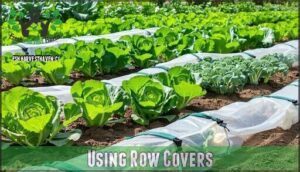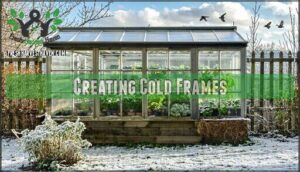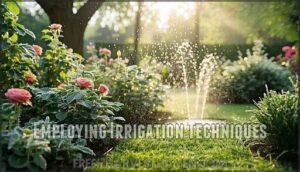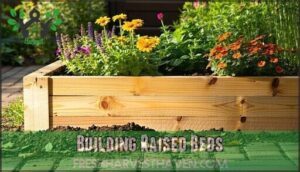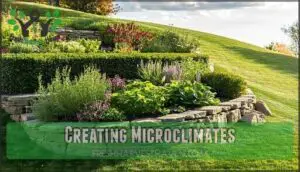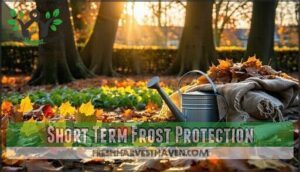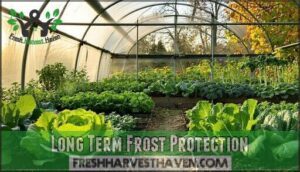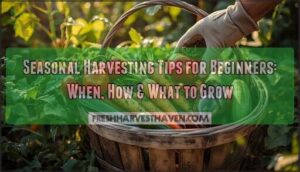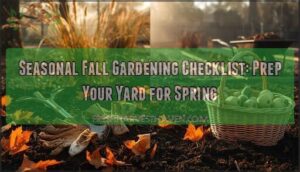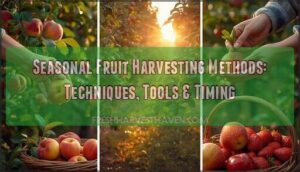This site is supported by our readers. We may earn a commission, at no cost to you, if you purchase through links.
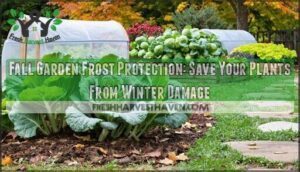
Start with row covers, cold frames, or even old bed sheets for immediate protection when frost threatens. Water your plants before expected frost—moist soil retains heat better than dry soil, creating a natural warming effect around root zones.
Position tender plants near south-facing walls or create microclimates using mulch and protective barriers. Don’t forget that some plants actually taste better after light frost, like kale and Brussels sprouts.
The secret lies in combining quick fixes with smart garden design that naturally resists cold damage, using techniques like these to ensure your garden remains healthy and thriving.
Table Of Contents
- Key Takeaways
- Frost Damage Prevention
- Protecting Plants From Frost
- Garden Design Strategies
- Plant Vulnerability Factors
- Short Term Frost Protection
- Long Term Frost Protection
- Frequently Asked Questions (FAQs)
- What plants need to be covered at 40 degrees?
- Should I cover my plants at 39 degrees?
- Can plants survive one night of frost?
- At what temperature should I cover my vegetable garden?
- What is the best thing to cover plants from frost?
- How to protect plants from frost?
- What plants should be protected during a frost or freeze event?
- How do I protect my plants in the fall?
- When do you need frost protection for plants?
- How to protect plants from a frosty chill?
- Conclusion
Key Takeaways
- You’ll protect tender plants by covering them when temperatures drop to 35°F or below – use row covers, cold frames, or breathable materials like old sheets before sunset to trap warm air around vulnerable crops like tomatoes and peppers.
- Water your soil thoroughly before frost hits – moist ground retains heat better than dry soil, releasing warmth overnight that creates natural protection around your plants’ root zones.
- Create permanent microclimates using smart garden design – position plants near south-facing walls, build raised beds for better drainage, and use thermal mass objects like water barrels to naturally moderate temperatures.
- Combine quick fixes with long-term strategies – while emergency covers work for unexpected frost, building cold frames and hoop houses extends your growing season well into winter for continuous harvests.
Frost Damage Prevention
Understanding which plants face frost danger helps you protect your garden before winter arrives.
Your frost protection success depends on recognizing the warning signs and knowing which plants need immediate attention when temperatures drop.
Identifying Frost Vulnerable Plants
When frost threatens, you can’t afford to guess which plants will survive. Start by checking your frost sensitive plants first—they’re the most vulnerable.
Here’s how to identify which plants need immediate protection:
- Tender annuals like tomatoes, peppers, and basil blacken at 32°F
- Warm-season vegetables including beans, cucumbers, and squash die with light frost
- Tropical houseplants such as coleus and impatiens can’t handle temperatures below 35°F
- Seedlings and young transplants lack the plant hardiness to survive cold snaps
- Flowering/fruiting crops lose blossoms and abort fruit when exposed to frost damage
Your frost hardy plants like kale, Brussels sprouts, and spinach actually improve in flavor after cold exposure. These frost tolerant plants handle temperatures down to 28°F without winter preparation, while your frost vulnerable plants need covering at the first hint of cold weather.
Understanding Frost Types
When winter approaches, you’ll face four distinct frost types that threaten your garden differently.
Radiation frost forms on clear, calm nights as heat escapes upward, creating ice crystals on surfaces. Advection frost arrives with cold air masses and strong winds, causing widespread freeze damage.
Hoar frost produces feathery white crystals under humid conditions, while black frost kills plants without visible surface frost.
Understanding frost classification helps you choose appropriate frost protection methods for your frost sensitive plants versus frost hardy plants, ensuring effective frost damage prevention.
Effects of Frost on Plants
When ice formation occurs inside plant cells, it causes cell damage that shows up as blackened, water-soaked leaves.
You’ll spot frost damage signs quickly—wilted stems and shriveled flowers appear within hours.
Plant hardiness determines survival rates, with tender varieties showing immediate vulnerability while frost-tolerant plants handle cold stress better.
Understanding these responses helps identify which plants need frost protection methods. To minimize damage, gardeners must understand frost formation types and their effects on different plant species.
Protecting Plants From Frost
When frost threatens your garden, you can protect your plants using several proven methods that trap heat and create protective barriers.
Don’t wait for frost to arrive—smart gardeners prepare their defenses before winter strikes.
Row covers, cold frames, and strategic watering techniques work together to shield vulnerable plants from freezing temperatures that can destroy months of hard work, using methods that trap heat.
Using Row Covers
Garden fabric row covers act like protective shields for your plants during frost protection. These lightweight Row Cover Materials trap warm air while allowing light and water through, providing 2-8°F of frost protection.
Here’s how fabric row covers work their magic:
- Cover Installation over wire hoops prevents fabric from touching leaves
- Secure edges with rocks or sandbags to trap ground heat effectively
- Remove covers by mid-morning to prevent overheating and allow ventilation
Frost Protection Methods using row covers reduce frost damage by 50-70% compared to uncovered plants. Install these frost protection covers before sunset when temperatures drop below 40°F, then watch your garden weather the storm. Gardeners can also explore row cover options to find the best materials for their specific needs.
Creating Cold Frames
Think of your cold frame as a portable greenhouse that transforms scraps into garden gold.
You’ll need Cold Frame Materials like reclaimed windows, rot-resistant cedar, and sturdy hinges for proper Frame Construction. Position it facing south to maximize solar heating throughout your Winter Gardening season.
These garden cold frame structures require no electricity while delivering exceptional fall garden protection. Add Insulation Methods like straw around the base for enhanced frost protection covers effectiveness.
Your DIY garden frost protection system extends harvests well into winter months. Understanding frost damage types is vital for effective protection strategies.
Employing Irrigation Techniques
Water’s your secret weapon when frost threatens your garden—it releases heat as it freezes, creating protective microclimates around vulnerable plants.
When frost strikes, water becomes your garden’s lifeline—transforming from liquid protector to frozen shield.
Deep watering before frost hits keeps soil moisture levels ideal for maximum heat retention.
Here’s how irrigation techniques save your plants:
- Turn on sprinkler systems before temperatures drop—continuous water flow maintains protective ice coating
- Install drip irrigation for targeted soil moisture around root zones
- Water thoroughly in late afternoon to maximize overnight heat release
- Keep systems running all night during frost warnings for continuous protection
- Focus on tender plants first—they need the most water conservation help
This frost protection method works because water releases latent heat during freezing, keeping plant tissues above damaging temperatures while maintaining critical soil moisture levels.
Effective sprinkler systems are essential for frost protection and plant conservation.
Garden Design Strategies
Smart garden design naturally shields your plants from frost by working with your landscape’s existing features.
You can position tender plants in protected spots and create warmer zones that extend your growing season without extra effort, utilizing the concept of complete concepts to improve garden productivity.
Utilizing South Facing Slopes
Slope Orientation transforms your fall garden into a fortress against frost damage through strategic Terrain Advantage and natural Microclimate Creation.
South facing slopes harness maximum Sunlight Maximization while cold air naturally drains downhill, creating perfect conditions for frost protection in your cold weather gardening setup.
Position your fall garden thoughtfully using these frost protection techniques:
- Plant tender varieties on upper slope areas where cold air won’t settle
- Utilize natural drainage patterns that pull frigid air away from plants
- Maximize morning sun exposure to quickly warm soil and foliage
- Create windbreaks on northern edges to block harsh winter winds
This smart positioning prevents Soil Erosion while establishing natural defenses that work around the clock for your garden’s survival.
Building Raised Beds
Raised beds boost your garden’s frost protection by warming up faster than ground-level soil.
Bed Construction with cedar or composite Raised Bed Materials guarantees durability, while 8-12 inch heights improve Bed Drainage and soil temperature.
Strategic Garden Layout places beds where morning sun hits first.
Soil Mixing with organic matter enhances heat retention, giving plants several extra degrees during chilly nights.
This fall gardening tips approach provides excellent frost protection for gardens through improved garden frost protection and protecting plants from frost naturally.
Creating Microclimates
Your garden’s micro climate can naturally extend growing seasons by creating protective zones that trap warmth and block harsh conditions. Strategic placement transforms ordinary spaces into frost-resistant havens.
Thermal mass objects like water barrels and stone walls absorb daytime heat, then release it overnight—raising temperatures by up to 3°F around sensitive plants. Position these thermal mass elements near your most vulnerable crops for maximum protection.
Wind breaks from evergreen hedges or fences reduce cold air infiltration by 50%, while soil insulation through mulching stabilizes root temperatures. This urban shelter approach works especially well in small spaces.
Here’s how to create effective microclimates:
- South-facing placement – Position tender plants against warm walls for 2-4°F temperature boost
- Grouping strategy – Cluster plants together to share warmth and reduce heat loss
- Water features – Add small ponds near beds to moderate temperature swings
- Elevated positioning – Use raised areas where cold air naturally drains away
These methods work better than traditional garden frost blanket or row covers for long-term protection, though cold frames remain excellent backup options.
Plant Vulnerability Factors
Your plants’ cold tolerance depends on their specific vulnerability levels, which determine when they’ll face frost damage.
Understanding these vulnerability factors helps you prioritize protection efforts and choose appropriate strategies for each plant type in your garden, based on their cold tolerance.
Tender Plants Protection
Frost-sensitive flowers and tender plants face winter’s harsh reality below 35°F. Quick action saves your precious specimens through plant insulation strategies.
Tender care begins with relocating container plants to heated spaces like garages or basements. Frost blankets and cold wraps create protective barriers for immovable plants. Winter shields work best when applied before sunset and removed by mid-morning.
| Protection Method | Temperature Range | Application Time | Effectiveness |
|---|---|---|---|
| Indoor relocation | All freezing temps | Before first frost | 100% success |
| Frost blankets | 28-35°F | Evening application | 85% protection |
| Cold wraps | 30-32°F | Overnight coverage | 75% success |
| Emergency covers | Light frost only | Last-minute protection | 60% effectiveness |
Protecting plants from frost requires preparation, not panic.
Hardy Plants Care
Unlike tender plants that need constant protection, hardy plants come equipped with built-in frost protection mechanisms.
These coldhardy plants naturally enter dormancy when temperatures drop, conserving energy for spring growth.
Your fall garden care should focus on proper soil preparation and root protection through mulching.
Avoid late-season winter pruning that stimulates vulnerable new growth.
Smart plant selection and understanding plant hardiness zones guarantees your dormancy care routine matches each variety’s natural defenses.
Frost Tolerant Plants Identification
Building on your knowledge of hardy plants, you’ll want to master frost tolerant plants identification for successful winter gardening.
These cold hardy plants with superior freeze tolerance thrive in harsh conditions through smart plant selection. Understanding cold weather protection is essential for maintaining a healthy garden during frost.
Frost resistant varieties handle temperatures down to 28°F:
- Hardy vegetables like kale, spinach, and Brussels sprouts actually sweeten after cold exposure
- Root vegetables including carrots, beets, and turnips develop better flavor following frost
- Brassicas such as cabbage, broccoli, and cauliflower show excellent frost protection naturally
Short Term Frost Protection
When unexpected frost threatens overnight, you’ll need immediate action to save your plants.
Frost blankets and row covers provide instant protection – just drape them over vulnerable crops before sunset.
Apply winter mulch around plant bases to insulate roots.
Water soil thoroughly in late afternoon; moist ground retains heat better than dry earth, creating natural frost traps that shield your garden from damage.
Long Term Frost Protection
When autumn arrives, you’ll need strategies that extend beyond quick overnight fixes to keep your garden thriving through the entire cold season.
Long-term frost protection involves building permanent or semi-permanent structures that create controlled growing environments, allowing you to harvest fresh vegetables well into winter and get a head start on spring planting.
Building Cold Frames
Think of your cold frame as a miniature greenhouse that’ll keep your plants thriving through winter’s harsh embrace. These simple structures trap solar heat effectively, creating a cozy microclimate for your vegetables when outdoor temperatures plummet.
Start your Frame Construction with basic Cold Frame Materials: recycled windows work perfectly for the top, while cedar or treated lumber forms the walls. Build your frame 12-18 inches tall with a slanted roof facing south to maximize sun exposure. This orientation captures maximum solar energy for natural Season Extension.
Add weather stripping for proper sealing and install hinges for ventilation control. These Insulation Methods prevent overheating while maintaining frost protection. Your Winter Gardening efforts will reward you with fresh greens long after traditional gardens have surrendered to winter’s grip.
Using Hoop Houses
Hoop houses transform your winter garden into a frost-resistant haven. These tunnel-like structures create protective microclimates that boost soil temperature by 4-10 degrees, giving your cold-tolerant crops the edge they need.
By understanding frost protection methods, gardeners can make informed decisions about their seasonal extensions.
Hoop house design elements for ideal season extension:
- Material selection – Choose 4-6 mil polyethylene for maximum light transmission while maintaining durability through harsh weather
- Ventilation systems – Install roll-up sides or louvre vents to prevent overheating during unexpected warm spells
- Crop selection – Focus on cold-hardy vegetables like kale, spinach, and Brussels sprouts that thrive in controlled environments
Creating Greenhouses
While hoop houses work well for seasonal protection, permanent greenhouses deliver year-round growing power.
Greenhouse materials like polycarbonate panels provide excellent insulation methods compared to traditional glass houses.
| Feature | Mini Greenhouses | Portable Greenhouse | Cold Frame |
|---|---|---|---|
| Size | 4-6 feet | 6-12 feet | 2-4 feet |
| Cost | $50-200 | $200-800 | $30-150 |
| Season | 3-4 months | 6-8 months | 2-3 months |
Solar heating systems and greenhouse ventilation fans maintain ideal temperatures automatically. Modern designs transform your frost protection into a controlled growing environment.
Frequently Asked Questions (FAQs)
What plants need to be covered at 40 degrees?
At 40°F, no plants need covering since frost damage occurs below 32°F. However, extremely tender plants like tropical houseplants and some seedlings might benefit from protection.
Should I cover my plants at 39 degrees?
Most plants don’t need frost protection at 39°F since frost typically occurs at 32°F or below.
However, extremely tender plants like tropical houseplants and some seedlings might benefit from light covers as a precaution against unexpected temperature drops, which can be a precaution.
Can plants survive one night of frost?
Yes, many plants can survive one night of frost, but it depends on their hardiness and the frost’s severity.
Hardy vegetables like kale and cabbage tolerate temperatures down to 28°F, while tender plants like tomatoes get damaged at 32°F.
At what temperature should I cover my vegetable garden?
When nighttime temperatures threaten to drop below 35°F, it’s time to tuck your garden in for the night.
Cover tender vegetables like tomatoes and peppers at 35°F, frost-tolerant crops at 32°F.
What is the best thing to cover plants from frost?
Row covers are your best bet for frost protection. These lightweight fabrics trap warm air while allowing light and water through, creating perfect microclimates for your plants.
How to protect plants from frost?
Late fall frosts damage up to 30% of unprotected garden crops.
Cover plants with breathable materials like row covers, blankets, or burlap before sunset.
Water soil thoroughly beforehand since moist ground retains heat better than dry soil, and using breathable materials can help protect the plants.
What plants should be protected during a frost or freeze event?
You’ll need to protect tender plants like tomatoes, peppers, beans, cucumbers, and tropical houseplants that can’t handle temperatures below 35°F. These warm-weather crops are highly susceptible to frost damage.
How do I protect my plants in the fall?
Like a gardener building armor for winter warriors, you’ll protect your plants by covering them with breathable fabrics, watering thoroughly before frost, and mulching vulnerable root systems for insulation.
When do you need frost protection for plants?
Start frost protection when nighttime temperatures drop to 36°F or below, especially for tender plants. Cover before sunset when clear, calm conditions forecast temperatures near 32°F for several hours overnight.
How to protect plants from a frosty chill?
Last winter, Sarah’s prized tomato plants survived an unexpected October frost using old bedsheets and strategic watering.
Cover plants with breathable materials before sunset, water soil thoroughly beforehand, and remove covers by mid-morning for proper ventilation to ensure the plants’ health and survival, which involves using breathable materials.
Conclusion
Like a vigilant gardener checking the thermometer at dawn, you’ll know that successful fall garden frost protection depends on preparation and timing.
Research shows that plants protected by row covers survive temperatures 4-6 degrees colder than unprotected ones.
Your fall garden frost protection strategy combines immediate solutions like covers and watering with long-term planning through microclimates and cold frames.
Remember that some vegetables actually improve after light frost, so you’re not just protecting plants—you’re optimizing their flavor and extending your harvest season well into winter.

